July 2019 LIP of the Month
Giant Circumferential Mafic Dyke Swarms
Kenneth L. Buchana and Richard E. Ernstb,c
aGeological Survey of Canada, 601 Booth Street, Ottawa, Canada K1A 0E8, kenneth.buchan@canada.ca
bDepartment of Earth Sciences, Carleton University, Ottawa, Canada K1S 5B6
cFaculty of Geology and Geography, Tomsk State University, 36 Lenin Ave, Tomsk, 634050, Russia, richard.ernst@ernstgeosciences.com
Extracted from:
Buchan, K.L., Ernst, R.E. (2019) Giant Circumferential Dyke Swarms: Catalogue and Characteristics. In: Srivastava, R.K., Ernst, R.E., Peng, P. (eds.) Dyke Swarms of the World – A Modern Perspective. Springer, p. 1-44.
Buchan, K.L., Ernst, R.E. (2018). A giant circumferential dyke swarm associated with the High Arctic Large Igneous Province (HALIP). Gondwana Research 58: 39-57.
For full details, see these references
Summary
Giant circumferential swarms represent a new class of mafic dyke swarms. They were initially recognized in Ernst and Buchan (1998), but more fully characterized in Buchan and Ernst (2018, 2019). Giant circumferential dyke swarms have a primary geometry that is quasi-circular or quasi-elliptical and have outer diameters that range from ~450 to ~2500 km. All of the currently identified giant circumferential swarms are of mafic composition. Many, but not all, are associated with a roughly coeval giant radiating dyke swarm whose focus is at or near the centre of the circumferential system, and can be linked with a mantle plume.
Examples of Giant Circumferential Swarms on Earth
The locations of currently recognized and possible giant circumferential dyke swarms are shown in Fig. 1. Four prominent examples are shown in Figs. 2-5. Buchan and Ernst (2018) reconstructed a giant circumferential dyke swarm belonging to the ca. 135-75 Ma High Arctic LIP (HALIP) (Fig. 2). Ernst and Buchan (1998, 2001) identified circumferential swarms for the 250 Ma Siberian Traps LIP (Fig. 3), ca. 980-930 Ma Rogaland (Scandinavia) event (Fig. 1) and 1110-1185 Ma Keweenawan LIP (North America) (Fig. 4). Mäkitie et al. (2014), and Ruotoistenmäki (2014) described a ca. 1380 Ma giant circumferential swarm at Lake Victoria in east Africa (Fig. 5) which can be linked to the widespread Kunene-Kibaran LIP across central Africa (Makitie et al. 2014, Ernst 2014; Buchan and Ernst, 2019).
The additional examples (Fig. 1) include circumferential swarms associated with the 65 Ma Deccan (India) and 135-120 Ma Paraná-Etendeka (South America and Africa) LIPs, and possible circumferential swarms linked to the 62-54 Ma North Atlantic, ca. 92-88 Ma Madagascar (Madagascar and India), ca. 183 Ma Karoo (southern Africa), ca. 370 Ma Yakutsk-Vilyui (Siberia), 720 Ma Franklin (North America), ca. 1110 Ma Umkondo (Africa), ca. 1210 Ma Marnda Moorn (Australia) and ca. 1780 Ma Xiong’er-Taihang (northern China) LIPs.
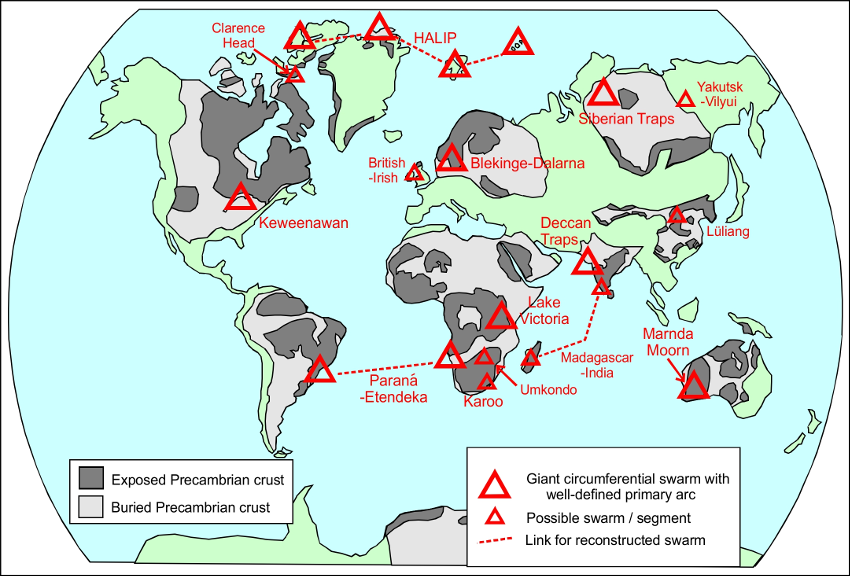
Figure 1: Global distribution of giant circumferential dyke swarms and possible segments of giant circumferential dyke swarms. Characteristics of each are detailed in Buchan and Ernst (2019) and references therein. Four examples of prominent circumferential swarms are illustrated in Figures 2-5. After Buchan and Ernst (2019).
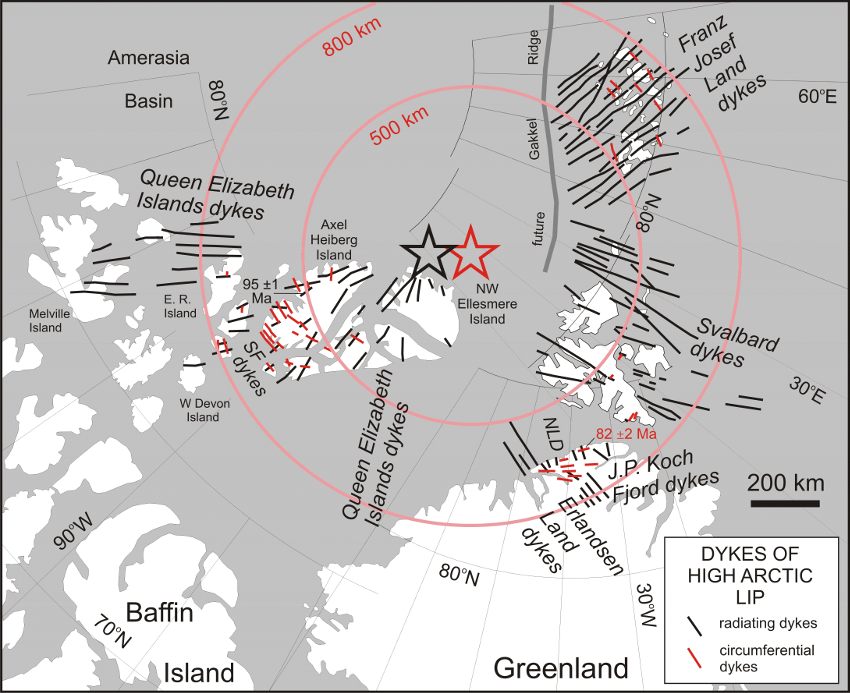
Figure 2: Circumferential (red) and radiating (black) dykes of the reconstructed 135-75 Ma High Arctic LIP (HALIP) of the Canadian Arctic islands, northern Greenland, Svalbard and Franz Josef Land. The circumferential swarm has an outer boundary of approximately 1600 km. The reconstruction is based on closing the Eurasia Basin, which opened in the Paleogene along the Gakkel Ridge, and Baffin Bay, and undoing deformation in the Queen Elizabeth Islands (as described in Buchan and Ernst 2018). Pink circles indicate the approximate outer and inner dimensions of the circumferential swarm. The red star is the centre of the circumferential swarm. The black star is the focus of the radiating swarm. U-Pb ages for a circumferential dyke (Thórarinsson et al. 2015) and a probable radiating dyke (Kingsbury et al. 2018) are indicated with red and black lettering respectively. SF dykes = Surprise Fiord dykes; E.R. Island = Ellef Ringnes Island. NLD = Nansen Land dykes. Nansen Land dykes form a dense N-trending swarm along the northern Greenland coast. They are coloured green, as they may not be part of the HALIP radiating swarm, but rather may be related to rifting that led to the opening of the Eurasia Basin (e.g., Thórarinsson et al. 2015). In addition, although a U-Pb age of 81 Ma has been reported for these dykes (Thórarinsson et al. 2015), paleomagnetic data suggests that some Nansen Land dykes may be Early Carboniferous rather than Cretaceous in age (Abrahamsen et al. 1997). After Buchan and Ernst (2019).
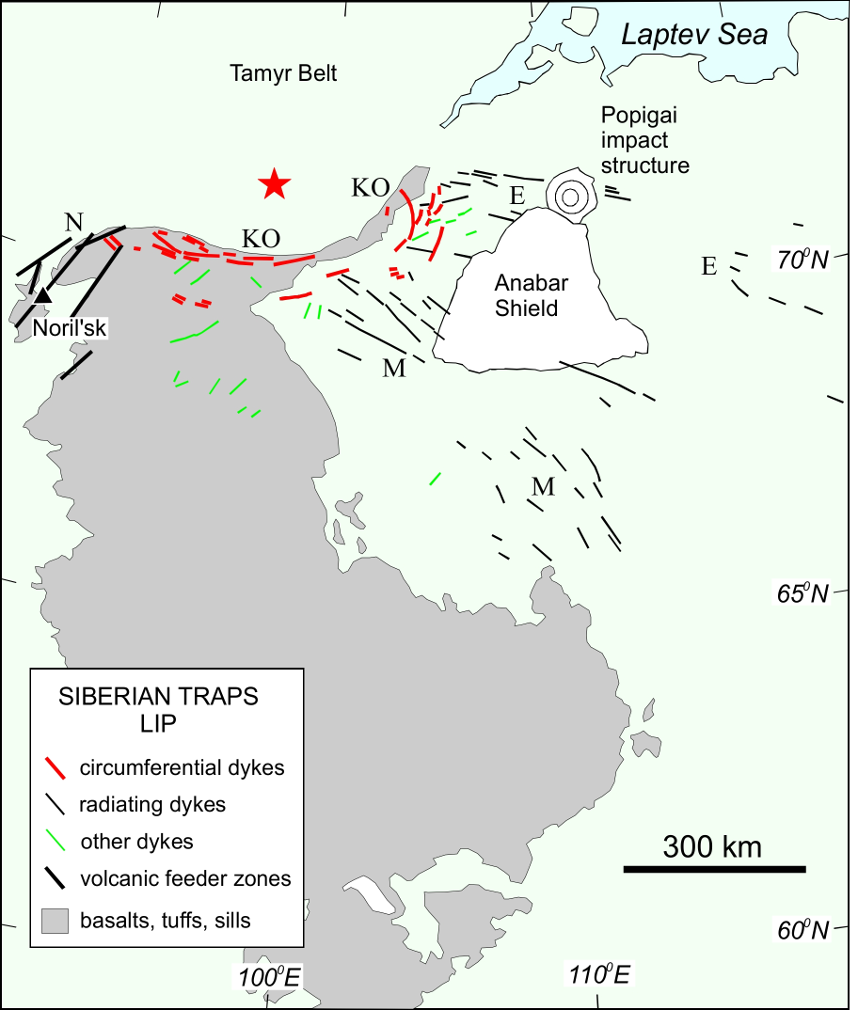
Figure 3: Circumferential (red) and radiating (black) dykes and (black) volcanic feeder zones of the ca. 250 Ma Siberian Trap LIP (modified after Ernst and Buchan, 2001, with additional circumferential dykes from Ryabov et al., 2014, Fig. 2.30). The red star locates the approximate focus of the radiating swarm and the centre of the circumferential swarm. The elliptical-shaped circumferential swarm has maximum and minimum outer diameters of about 600 and 300 km. E = Ebekhaya dykes; KO = Kochikha dykes; M = Maimecha dykes; N = Noril’sk feeder zones to volcanic flows. After Buchan and Ernst (2019).
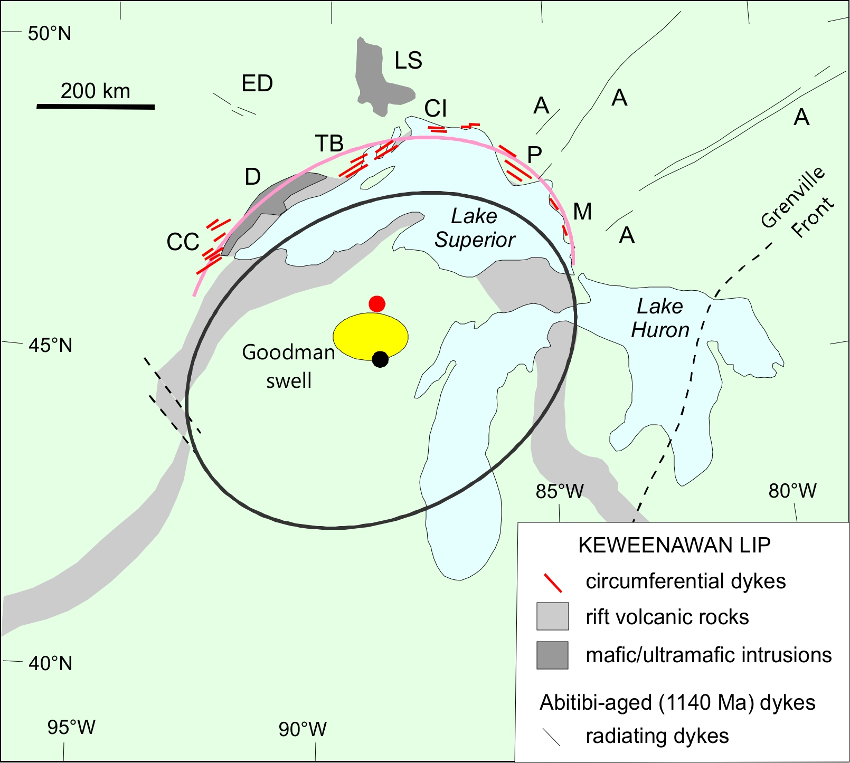
Figure 4: Circumferential (red) and radiating dykes (black) of the ca. 1110-1085 Ma Keweenawan LIP and precursor ca. 1140 Ma Abitibi magmatic event associated with the Mid-Continent Rift of North America. Rift-parallel dyke swarms: CC = Carleton County, TB/PR = Thunder Bay (Pigeon River), CI = Copper Island, P = Pukaskwa, M = Mamainse Point. Other mafic/ultramafic intrusions: D = Duluth anorthosite complex, LS = Logan (Nipigon) sills. Radiating dykes: A = Abitibi dykes, ED = Eye Dashwa dykes. L = lamprophyre dykes. The Goodman swell (Peterman and Sims 1988) may locate the centre of a Keweenawan mantle plume as described in Buchan and Ernst (2019). The northern portion of the black ellipse (centred at the black dot) roughly matches the geometry of the rift system in the Lake Superior region. If shifted north ~80 km (as the pink arc centred at the red dot) to reflect opening of the rift, it roughly matches the curvature of the dyke swarms along the northern Lake Superior shore. Linear Keweenawan Baraga and Mellen-Gogebic dyke swarms (e.g., Buchan and Ernst 2004) that occur south of Lake Superior are not shown. U-Pb ages for radiating 1140 Ma Abitibi (Krogh et al. 1987) and lamprophyre (Queen et al. 1996) swarms are shown in black lettering. A U-Pb age for a Pigeon River circumferential dyke (Heaman et al. 2007) is shown in red. The 1150 Ma Corson diabase (not shown) is located to the west of the Keweenawan rift in southeastern South Dakota at about 44N, 97 W (McCormick et al. 2017). These 1150-1140 Ma units likely represent a precursor magmatic pulse to the main Keweenawan LIP and could be associated with initial plume arrival. After Buchan and Ernst (2019).
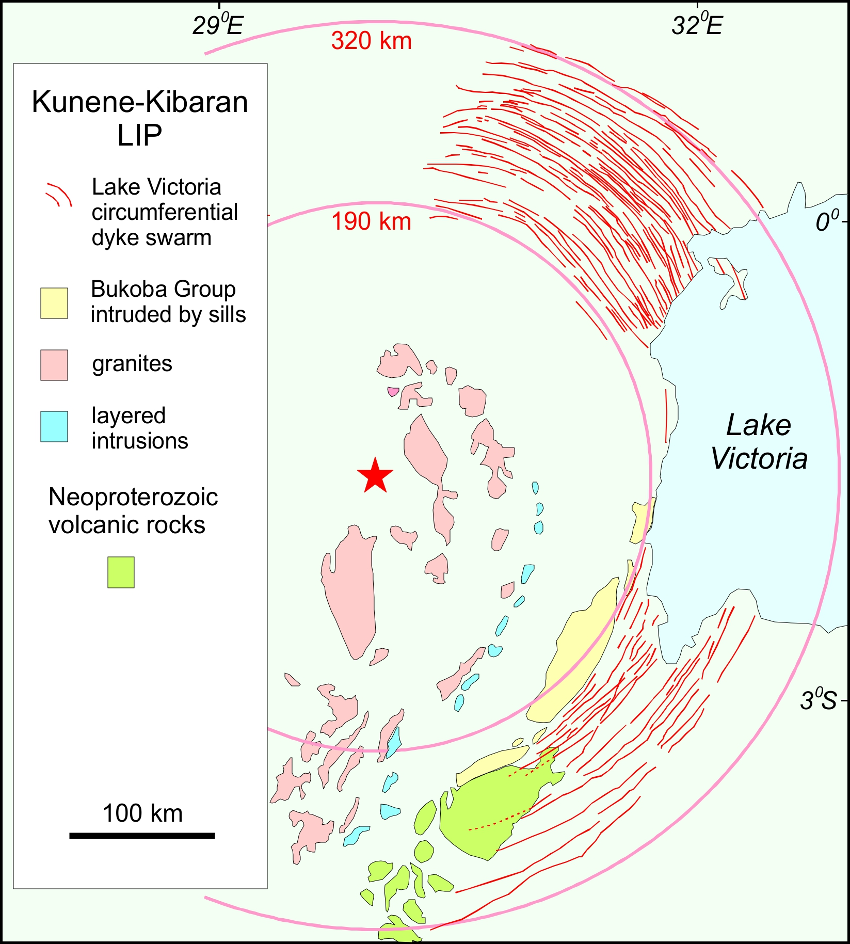
Figure 5: Ca. 1370 Ma giant circumferential Lake Victoria dyke swarm of the Kunene-Kibaran LIP of eastern Africa, traced mainly from aeromagnetic data. Dashed pink circles indicate the approximate outer and inner dimensions of the swarm; the outer diameter is approximately 650 km. The red star locates the centre of the swarm. The figure is modified after Mäkitie et al. (2014), with the Bukoba Group after Tack et al. (2010). After Buchan and Ernst (2019).
Characteristics of Giant Circumferential Swarms
Giant radiating swarms and giant circumferential swarms are usually interpreted to focus above mantle plume centres and form a key component of the plumbing system of LIPs (Fig. 6; Ernst et al. 2019). However, other giant circumferential swarms, without an associated radiating swarm, may or may not be plume related (e.g. the Blekinge-Dalarna example is likely not plume related).
It should be noted that some giant dyke swarms have an arcuate pattern as the result of secondary deformation, or as the result of deflection from a linear or radiating geometry in the presence of a regional stress field (Ernst et al. 1995; Ernst, 2014). Such swarms are not considered to be giant circumferential swarms.
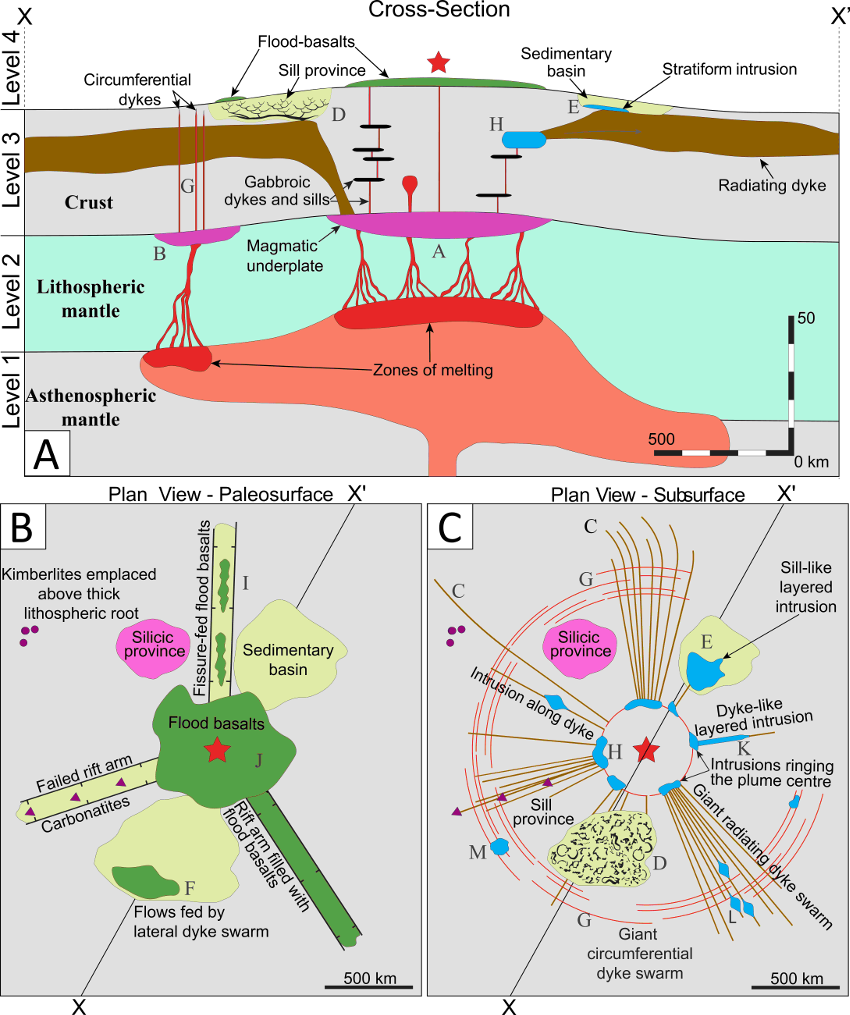
Figure 6: Framework for the plumbing system of continental large igneous provinces (LIPs) associated with mantle plumes: A) cross section, B) paleosurface plan view. C) subsurface plan view. Magmatic units are colored by type of unit: magmatic underplate (purple), mafic-ultramafic intrusion (blue), mafic sills (black), radiating mafic dykes (brown), circumferential mafic dykes (red), and flood basalts (green). Associated units include silicic magmatism (pink). carbonatites (purple triangles), and kimberlites (purple circles). Red star indicates mantle plume center location and scales are typical, although LIP events can be both smaller and larger than depicted. Letters provide a link to key discussion points in Ernst et al. (2019). Note, thicker lithosphere on the right side of the cross section which would inhibit mafic magmatism on that side of the plume and thus prevent circumferential dykes on that side (see gap in circumferential pattern on upper right side of part B). After Ernst et al. (2019).
The largest giant circumferential swarm have diameters comparable to the diameters postulated for the flattened heads of plumes that have risen from the core-mantle boundary, suggesting that they may be associated with the outer edge of a flattening or flattened mantle plume head (Fig. 6). Smaller giant circumferential swarms could be linked with small plumes from the mid-mantle or with the edge of a magmatic underplate above a plume head (Fig. 6). See Buchan and Ernst (2019) for discussion of mechanisms of formation of circumferential swarms.
It should be noted that, in addition to the giant circumferential swarms that are the subject of this study, there are much smaller circumferential swarms with diameters that range from a few kilometres to several tens of kilometres or more. The intrusions of these swarms are usually referred to as ring dykes if vertical or outward dipping, and cone sheets if inward dipping (e.g., Neuendorf et al. 2005).
Giant circumferential dyke swarms on Earth may be analogues of coronae on Venus and similar features on Mars (Buchan et al. 2016; Bethell et al. 2016; Buchan and Ernst, 2019). Coronae are large tectono-magmatic features ranging in size up to 2500 km in diameter, that typically consist of a quasi-circular or quasi-elliptical graben-fissure system and associated topography (central uplift or depression, and circular rim or moat). In some instances, they are linked to a giant radiating graben-fissure system and LIP-scale volcanism. Both giant radiating and circumferential graben systems on Venus and Mars have been interpreted to be underlain by dykes, supporting this idea of Venusian corona and similar features on Mars as analogues of terrestrial giant circumferential dyke swarms (e.g. Buchan and Ernst 2019).
References
Abrahamsen, N., Bengaard, H.-J., Friderichsen, J.D., Van der Voo, R. 1997. Palaeomagnetism of three dyke swarms in Nansen Land, northern Greenland (83° N). Geologie en Mijnbouw 76: 83-95.
Bethell, E., Ernst, R.E., Samson, C., Buchan, K.L. 2016. Circumferential graben-fissure systems of Venusian coronae as possible analogues of giant circumferential dyke swarms on Earth. Lunar and Planetary Science Conference 47, Abstract #1471.
Buchan, K.L., Ernst, R.E. 2016. Giant circumferential dyke swarms on Earth as possible analogues of coronae on Venus. Lunar and Planetary Science Conference 47, Abstract #1183.
Buchan, K.L., Ernst, R.E. 2004. Diabase dyke swarms and related units in Canada and adjacent regions. Geological Survey of Canada, Map 2022A, scale: 1:500 000.
Buchan, K.L., Ernst, R.E. 2018. A giant circumferential dyke swarm associated with the High Arctic Large Igneous Province (HALIP). Gondwana Research 58: 39-57.
Buchan, K.L., Ernst, R.E. (2019) Giant Circumferential Dyke Swarms: Catalogue and Characteristics. In: Srivastava, R.K., Ernst, R.E., Peng, P. (eds.) Dyke Swarms of the World – A Modern Perspective. Springer, p. 1-44.
Ernst, R.E. 2014. Large Igneous Provinces. Cambridge University Press, Cambridge, 653 p.
Ernst, R.E., Buchan, K.L. 1998. Arcuate dyke swarms associated with mantle plumes on Earth: implications for Venusian coronae. Lunar and Planetary Science Conference #29, abstract #1021.
Ernst, R.E., Buchan, K.L. 2001. The use of mafic dyke swarms in identifying and locating mantle plumes. In: Ernst, R.E., and Buchan, K.L. (eds.), Mantle plumes: their identification through time. Geological Society of America, Special Paper 352, p. 247-265.
Ernst, R.E., Buchan, K.L., Palmer, H.C. 1995. Giant dyke swarms: Characteristics, distribution and geotectonic applications. In: Baer, G., and Heimann, A. (eds.), Physics and chemistry of dykes, Balkema, Rotterdam, p. 3-21.
Ernst, R.E., Liikane, D.A., Jowitt, S.M., Buchan, K.L., Blanchard, J.A. (2019). A new plumbing system framework for mantle plume-related continental large igneous provinces and their mafic-ultramafic intrusions. Journal of Volcanology and Geothermal Research, v. 384, p. 75–84.
Heaman, L.M., Easton, R.M., Hart, T.R., Hollings, P., MacDonald, C.A., Smyk, M. 2007. Further refinement to the timing of Mesoproterozoic magmatism, Lake Nipigon region, Ontario. Canadian Journal of Earth Sciences 44: 1055-1086.
Kingsbury, C.G., Kamo, S.L., Ernst, R.E., Soderlund, U., Cousens, B.L. 2018. U-Pb geochronology of the plumbing system associated with the Late Cretaceous Strand Fiord Formation, Axel Heiberg Island, Canada. Journal of Geodynamics 118: 106-117.
Krogh, T.E., Corfu, F., Davis, D.W., Dunning, G.R., Heaman, L.M., Kamo, S.L., Machado, N. 1987. Precise U-Pb isotopic ages of diabase dykes and mafic to ultramafic rocks using trace amounts of baddeleyite and zircon. In: Halls, H.C., and Fahrig, W.F. (eds.), Mafic dyke swarms, Geological Association of Canada, Special Publication 34, p. 331–348.
Mäkitie, H., Data, G., Isabirye, E., Mäntärri, I., Huhma, H., Klausen, M.B., Pakkenen, L., Virransaio, P. 2014. Petrology, geochronology and emplacement model of the giant 1.37 Ga arcuate Lake Victoria Dyke Swarm on the margin of a large igneous province in eastern Africa. Journal of African Earth Sciences 97: 273-296.
McCormick, K.A., Chamberlain, K.R., Paterson, C.J., 2017. U–Pb baddeleyite crystallization age for a Corson diabase intrusion: possible Midcontinent Rift magmatism in eastern South Dakota. Can. J. Earth Sci., 55(2): 111-117.
Neuendorf, K.K.E., Mehl, J.P.Jr., Jackson, J.A. 2005. Glossary of Geology, 5th edition, American Geological Institute, Alexandria, Virginia, U.S.A., 779 p.
Peterman, Z.E., Sims, P.K. 1988. The Goodman swell: a lithospheric flexure caused by crustal loading along the Midcontinent Rift system. Tectonics 7: 1077-1090.
Queen, M., Heaman, L.M., Hanes, J.A., Archibald, D.A., Farrer, E. 1996. 40Ar/39Ar phlogopite and U-Pb perovskite dating of lamprophyre dykes from the eastern Lake Superior region: evidence for a 1.14 Ga magmatic precursor in Midcontinent Rift volcanism. Canadian Journal of Earth Sciences 33: 958-965.
Ruotoistenmäki, T. 2014. Geophysical characteristics of Asza shear, Nagasongola discontinuity and ring dyke complex in Uganda. Journal of African Earth Sciences 93: 23-41.
Ryabov, V.V., Shevko, A.Ya., Gora, M.P. 2014. Trap magmatism and ore formation in the Siberian Noril’sk region, Volume 1, Trap petrology, Springer, 390 p.
Tack, L., Wingate, M.T.D., De Waele, B., Meert, J., Belousova, E., Griffin, B., Tahon, A., Fernandez-Alonso, M. 2010. The 1375 Ma “Kibaran event” in Central Africa: prominent emplacement of bimodal magmatism under extensional regime. Precambrian Research 180: 63-84.
Thórarinsson, S.B., Söderlund, U., Døssing, A., Holm, P.M., Ernst, R.E., Tegner, C. 2015. Rift magmatism on the Eurasia basin margin: U-Pb baddeleyite ages of alkaline dyke swarms in North Greenland, Journal of the Geological Society 172: 721-726.
